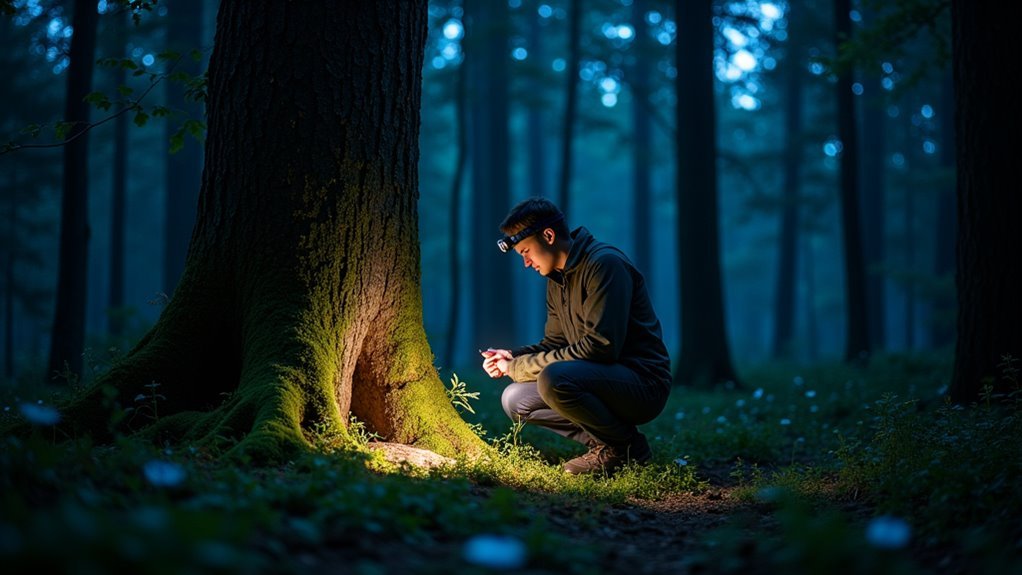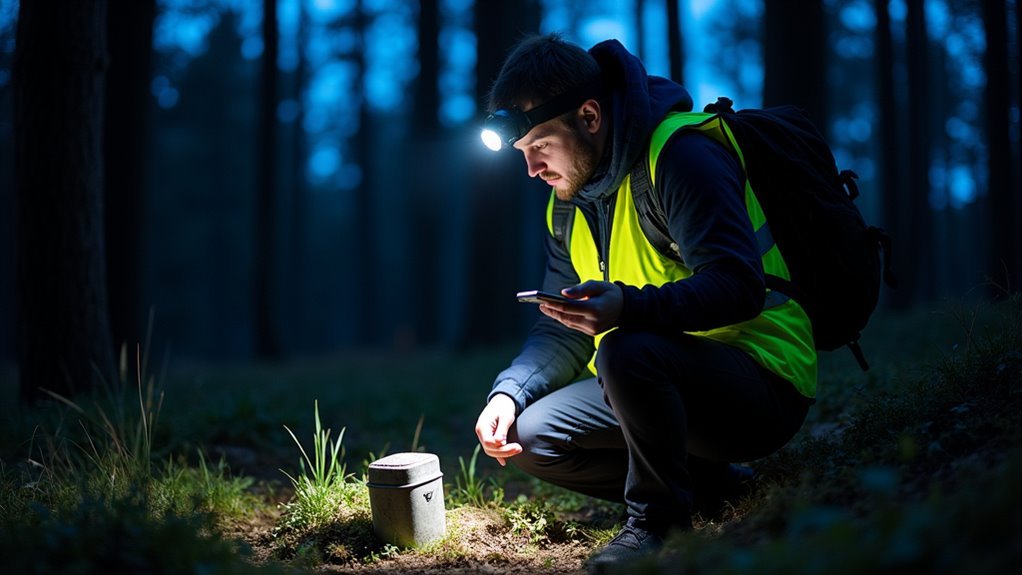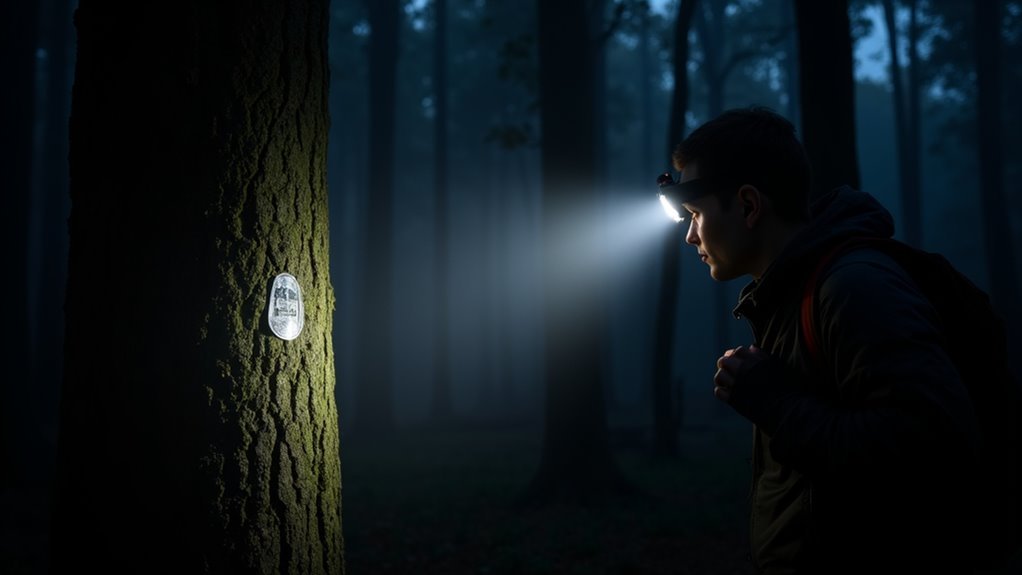Some of the links in this article may be affiliate links. If you make a purchase through these links, we may earn a small commission at no extra cost to you. Thank you.
I’ve been night geocaching for over five years now, and I’m convinced it’s the most underrated outdoor adventure you can have. There’s something magical about hunting for hidden treasures when the world goes quiet. I’ll never forget my first night cache—I was terrified but thrilled when my headlamp caught that first reflector winking back at me. If you’ve only cached during daylight, you’re missing half the experience. Want to know why?
What Makes Night Caches Special

Why are night caches so magical?
Well, they transform ordinary geocaching into something almost otherworldly.
Unlike daytime hunts, these adventures require flashlights or UV lights to reveal hidden paths marked with reflective tape or glow-in-the-dark markers.
These markers are practically invisible during daylight hours.
I’ve found that night caches often feature creative themes tied to the darkness—like the Milchstraße cache in Germany that connects to stars and constellations.
What I love most is how they create unique exploration experiences through illuminated paths.
Sometimes these paths span kilometers through spooky forests or around glacial erratics.
In my experience, the dedicated “Night cache” attribute on Geocaching.com helps identify these special adventures that’ll push your skills while rewarding you with, I think, the most memorable geocaching moments possible.
Essential Gear for Nocturnal Cache Hunters
I’ve learned the hard way that proper lighting is your first line of defense against the darkness, so I always recommend a high-quality headlamp with extra batteries on every hunt.
You’ll also want a reliable GPS device to navigate between waypoints, especially when coordinates change throughout a multi-cache adventure.
For safety’s sake, don’t forget backup illumination and some reflective clothing—trust me, when you’re deep in the woods at midnight, you’ll thank yourself for being prepared.
Lighting Tools
When you’re venturing into the shadowy world of night geocaching, your lighting tools aren’t just accessories—they’re absolutely essential for both success and safety.
I’ve found that a powerful headlamp is your best friend during Night adventures, freeing your hands while illuminating those tiny reflective tacks along the trail.
For some night caching experiences, you’ll definitely need a UV light—those glow-in-the-dark elements won’t reveal themselves otherwise!
I always pack a backup light source too; nothing worse than being stranded in darkness when batteries fail unexpectedly.
Safety Equipment
Traversing the nocturnal wilderness requires more than just light sources—you’ll need a solid safety kit to keep your night caching adventures from turning into misadventures.
When I’m searching for night caches, I never leave home without proper safety equipment—it’s just not worth the risk.
Your GPS is obviously essential, but don’t forget these safety must-haves:
- First aid kit with bandages, antiseptic wipes, and pain relievers
- Emergency whistle (three blasts is the universal distress signal)
- Weather-appropriate clothing with reflective strips
I’ve learned the hard way that terrain looks completely different after sunset.
What seems like a simple path during daylight can become treacherous at night.
Trust me, you’ll thank yourself for being prepared when you’re out there in the dark chasing that elusive cache.
Safety Protocols Every Night Geocacher Should Follow

I’ve learned the hard way that night geocaching requires serious safety measures beyond just carrying a good headlamp and extra batteries.
You’ll need to establish clear communication protocols with your group, including regular check-ins and predetermined meeting points in case someone gets separated.
I always prepare for the unexpected by packing a basic first aid kit, emergency whistle, and portable phone charger—trust me, you don’t want to be stuck in the woods at midnight with a dead phone!
Safety Gear Essentials
The darkness of night caching presents unique challenges that require specialized safety gear—you can’t just grab any old flashlight and hit the trails.
I’ve learned the hard way that proper illumination is non-negotiable for spotting those tiny reflectors while keeping your footing secure.
In my experience with GPS units, you’ll want to prioritize these essentials:
- A high-powered headlamp with spare batteries – this keeps your hands free while providing reliable light
- A backup flashlight – because, well, technology fails at the worst times
- Weather-appropriate layers – you might start warm but get cold as the night progresses
Don’t skimp on battery supplies either.
I think most night cachers underestimate how quickly GPS devices drain power when you’re constantly checking coordinates in the dark.
Group Communication Protocols
Safety gear alone won’t guarantee a successful night cache hunt—you’ll need solid communication strategies when darkness falls. In my experience, establishing clear protocols before heading out makes all the difference when you’re trying to pinpoint the location of the geocache in low visibility.
| Signal Type | Meaning | When to Use |
|---|---|---|
| 3 Quick Flashes | Stop/Regroup | When separated |
| Phone Check-in | Location confirmation | Every 15-30 minutes |
| Whistle (3 blasts) | Emergency help | When in trouble |
| Hand signal (palm up) | Wait | Before proceeding |
| Single long flash | Found cache | At Global Positioning target |
I always designate someone not hunting with us as my “safety contact.” They’ll know our route and expected return time—well, that’s saved my group more than once when our adventure ran longer than planned!
Emergency Preparedness Tactics
What happens when your carefully planned night geocaching adventure suddenly goes sideways?
Before the sun goes down, I always prepare for potential emergencies—because trust me, darkness amplifies every challenge.
Always leave your exact route details with someone reliable before you head to the start of the trail.
Here’s what I consider non-negotiable safety protocols:
- Inform a trusted contact of your route and expected return time
- Never geocache alone—bring at least one buddy who can help if you’re injured
- Pack redundant light sources—I’ve been saved by my backup headlamp more times than I’d like to admit!
Weather can turn nasty without warning, and that flat trail might actually hide ankle-twisting hazards.
Techniques for Spotting Reflectors and Trail Markers

Spotting trail markers in the darkness can feel like searching for stars on a cloudy night, but I’ve found it’s all about technique.
I always start at the posted coordinates with my high-powered flashlight held at eye level—this positioning is essential, trust me.
When scanning for reflectors, I sweep my beam slowly across trees, posts, and the ground.
You know how these reflective tacks work—they’re practically invisible until your light hits them just right, then bam!
They shine like tiny beacons.
I typically look for white or orange reflectors, though some cache owners use stealth colors.
Once I spot the first marker, I head straight to it, then search for the next one.
This connect-the-dots approach eventually leads to the final cache—if you’re patient enough!
Notable Night Cache Types Around the World
Every continent seems to have its own unique take on night geocaching, and I’ve been lucky enough to try a handful of these nocturnal adventures.
Night geocaching transforms with geography, each continent offering its own flavor of darkness-wrapped treasure hunts.
Germany’s Milchstraße Multi-Cache is probably my favorite, with its star-themed waypoints that make you feel like you’re traversing the cosmos.
The Mystery Cache types, like that spooky Sleepy Hollow one (D 3/T 4.5!), actually create the most immersive experiences.
What makes night caches special? Well, three things stand out:
- The cache type variation – from simple trail caches to complex multis
- Local themes that transform ordinary locations into adventures
- Different reflector setups that create unique navigation challenges
I’ve found that Canada’s Nite-A-Tack offers a perfect balance – challenging but not impossible, even for someone directionally challenged like me!
Planning Your First Night Caching Adventure
So you’re ready to plunge into the mysterious world of night caching?
Unlike regular geocaches, night cache containers often contain special surprises that only come alive after dark.
Before heading out, I always check the weather and study the terrain map—trust me, you don’t want to be caught in rain or unfamiliar territory on your first night out!
Make sure your headlamp is charged—actually, scratch that—make sure it’s fully charged with backup batteries.
Night caches depend on reflectors that won’t shine without a good light source.
I think bringing a buddy is essential, not just for safety but for sharing those “wow” moments.
And don’t forget to tell someone your plans.
Pack insect repellent too—mosquitoes love night cachers almost as much as we love the thrill!
Frequently Asked Questions
Can You Geocache in the Dark?
I’ve danced with shadows while geocaching in the dark through special “night caches.” You’ll need proper night equipment like headlamps to navigate dark terrain following reflective markers to hidden treasures.
Is Geocaching Still a Thing in 2025?
Yes, geocaching is definitely still thriving in 2025! I’ve noticed its popularity has grown through digital evolution, with active forums, new trackable features, and experimental developments keeping the community engaged year-round.
What Does GZ Mean When Geocaching?
When I’m geocaching, GZ is the abbreviation for “Ground Zero” – the exact spot where the cache is hidden. Reaching GZ requires coordinate precision to complete your geocaching hunt successfully.
What Are the Three Main Rules of Geocaching?
I’m supposed to say there are only three rules? Funny. The main cache etiquette includes: take something/leave something of equal value, always sign the logbook per logging rules, and leave no trace when rehiding.